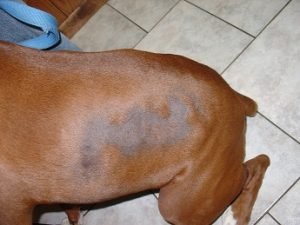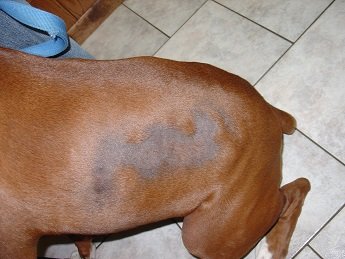Diabetic dogs can suffer from a lot of health problems, and unfortunately, some of them are not the most obvious. One common problem is hair loss, which can be caused by many different reasons, including diabetes itself. This post will look at how to spot this issue and what you might do about it if your dog does start losing his hair.

Why Dog loses its hair when suffering from diabetes?
Hair fall in a diabetic dog mainly occurs when a god suffers from a specific type of diabetes known as diabetes mellitus. In this type of diabetes, a dog’s immune system becomes susceptible to various infections and skin conditions. Due to diabetes mellitus, some dogs become allergic to flea bites which cause extreme redness, skin scales, and hair loss.
If your diabetic dog is losing hair, most probably it is suffering from this type of diabetes. However, the issue doesn’t end here. Apart from diabetes mellitus, normal diabetes can also cause various issues, including hair loss. Let’s discuss those in detail.
Calculate Your Diabetic Dog’s Daily Diet
Diagnosis of Hair Loss in Diabetic Dogs:
Being a pet owner can be frustrating and anxious. If your furry friend is experiencing hair loss, they should see the vet for an examination to find out what’s wrong with them.
In such cases, diagnosis is made on the skin condition, signs, the pattern of hair loss, skin condition around hair loss, itching, and other similar factors.
The pattern of hair loss
If your diabetic dog is suffering from normal hair loss, it can be an indication of bacterial infection. Observe your pet closely, and if you can see patches of hair loss, it means your pet is suffering from ringworm, bacterial infection, or mites.
Hair loss in dogs at the rump or tail base area is often caused by flea allergy. Hair loss on a dog’s paws and face are mainly caused due to environmental allergies or atopy. Moreover, symmetrical hair loss in a dog can be a sign of adrenal gland disorders, thyroid disorders, or unusual sex hormone levels.
Blood profile
Your vet might prescribe some blood testing to identify certain immune system conditions, hormone problems, thyroid disorders, Cushing’s disease, and Diabetes mellitus.
Biopsy
In diabetic dogs, hair loss can also occur due to severe issues such as skin cancer or a tumor. To confirm that your vet will send the portion of the affected area for further testing. Usually, you can see scales on your pet’s skin or skin lesions.
Why is my dog’s hair falling out?
In most diabetic dogs, allergies are a common trigger for severe hair loss. Like humans, dogs are also allergic to various foods, environmental elements such as pollen or parasites.
Will hair grow back if diabetes is controlled?
If the hair loss is associated with only diabetes, not from any of the mentioned reasons, they will come back. However, you need to adjust your pet’s diet, lifestyle, and medicine to control diabetes and get its hair back. Once your pet’s diabetes comes under control, first you will see a reduction in hair loss and then the new ones.
How to treat my diabetic dog’s hair loss?
Generally speaking, the following treatment methods and medicines are used for dogs losing hair:
- Antibiotics. To treat bacterial infections.
- Antifungals. To treat yeast and ringworm infections.
- Steroids. To strengthen pet’s hair
- Immunosuppressive medicines or anti-cytokine Drugs.
- Immunotherapy (in severe cases).
- Behavioral medications.
- Prescribed medicated shampoos.
- Hypoallergenic diets.
- General medicines to control blood glucose levels.
What disease causes dogs to lose hair?
There are many diseases due to which your dog can lose its hair. However, some of the most common ones include:
- Mange, a disease caused by the bug ‘Demodex.’
- Stress or Trauma
- Skin allergies and infections
- Various immune diseases
- Endocrine system abnormalities.
- Diabetes
Can my diabetic dog lose hair from stress?
When your diabetic dog is under-stressed, its body releases epinephrine, also called adrenaline, resulting in hair loss. The connection between stress and hair loss is not that clear, but it is seen that if a dog remains under stress for a long time, its fur will fly.
Can Diabetes Cause Hair Loss?
Yes, diabetes can cause hair loss in dogs. In some cases, diabetes can also make a dog’s fur thin and cause hair breakage. The primary reason for this is that high blood sugar levels affect the lymph and fat tissue. Disturbed lymph damages the nutrient supply to fur and hair and makes them susceptible to skin, scalp, and skin infections.
Can Insulin Resistance Cause Hair Thinning?
Insulin resistance can be another reason why your diabetic dog is losing hair. Remember that insulin resistance is the leading symptom of prediabetes, and it can cause sudden or abnormal hair fall. If that’s the case with your pet, the issue deserves your immediate attention and timely treatment.
What does alopecia in diabetic dogs look like?
Alopecia is the same in all dogs, regardless of whether they suffer from diabetes or not. In some cases, itching and skin inflammation can also result in alopecia. Depending on the exact reason and type of the alopecia, you might see round patches of hair loss, a moth-eaten look to your dog’s fur, or even symmetrical hair loss on various body parts.
How to Prevent Hair Loss In A Diabetic Dog?
Like diabetes in humans, diabetes in dogs must be closely monitored to avoid various issues, including hair loss, and eventually, your pet will live a longer, healthier life.
Furthermore, when a dog’s diabetes remains under control, they will not have abnormal thirst and urination times; they will enjoy a normal appetite, a stable body weight, good vision, and healthy hair and skin.
Generally, there are three significant parts of controlling blood sugar in dogs as well as humans. To prevent hair loss in diabetic dogs and other issues, you need to focus on your dog’s diet, blood glucose level, and exercise. Let’s briefly discuss these:
Diet
When diabetes occurs in dogs or other pets, you need to feed them dried and canned food items. However, never feed them semi-moist foods as they have high sugar content. Your vet’s recommendation is key here. Follow their advice about feeding your diabetic dog as it might be dependent on insulin.
Blood Glucose Monitoring
Apart from a healthy diet, you need to monitor your diabetic dog’s blood glucose levels. This is important as there are various types of diabetes. Leaving it untreated in the initial stage can lead to other diseases such as diabetes malleus or Cushing’s diseases. You will see various health issues in both these illnesses, including rapid hair loss.
Talk to your vet if you see rapid changes in sugar levels of your dog, and they will work out changes to the insulin dosage or type.
Exercise
Diabetes is more common in overweight or obese dogs. This is because excess fat leads to insulin resistance. Overweight dogs are more vulnerable to various problems. Hence to avoid such problems and to control the diabetes of your pet, engage him in daily walks.
In the End:
A diabetic dog losing hair is a common issue. If you ever notice your dog shedding excessively, especially in the warmer months when they don’t typically shed any hairs at all, it may be time to get them checked out by their veterinarian and see if there might be another reason for the change. The sooner you diagnose this condition and start treatment, the better it will be for your furry dog.
Let us know what symptoms you’ve noticed on your furry friend that could signify an endocrine disorder like diabetes malleus or hypothyroidism.


I have a female choodle , part chihuahua and part mini poodle she has been diabetic for 7 years and takes two shots of vetsulin twice a day, I’m strict on her diet as well , I’ve noticed lately thinning hair around neck and under belly ,what can I do to help this , she does not appear sick ,